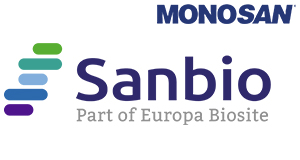Anti-PARP/PARP1 Picoband™ Antibody (monoclonal, 10G9)
Anti-PARP/PARP1 Picoband™ Antibody (monoclonal, 10G9)
SKU
SANMON23760
Packaging Unit
100μg
Manufacturer
Sanbio / Monosan
Availability:
loading...
Price is loading...
Clone Number: 10G9
Immunogen: E.coli-derived human PARP recombinant protein (Position: Q670-R858). Human PARP shares 94% and 95% amino acid (aa) sequence identity with mouse and rat PARP, respectively.
Concentration: Adding 0.2 ml of distilled water =f 500 μg/ml.
Format: Lyophilized
Storage buffer: Each vial contains 4mg Trehalose, 0.9mg NaCl, 0.2mg Na2HPO4, 0.05mg NaN3.
Additional info: Store at -20˚C for one year from date of receipt. After reconstitution, at 4˚C for one month. It can also be aliquotted and stored frozen at -20˚C for six months. Avoid repeated freeze-thaw cycles.Add 0.2 ml of distilled water will yield a concentration of 500 ug/ml. Background: Poly [ADP-ribose] polymerase 1 (PARP1), also known as ADPRT or PPOL is an enzyme that in humans is encoded by the PARP1 gene. PARP1 gene is mapped to 1q42.12. This gene encodes a chromatin-associated enzyme, poly (ADP-ribosyl)transferase, which modifies various nuclear proteins by poly (ADP-ribosyl)ation. The modification is dependent on DNA and is involved in the regulation of various important cellular processes such as differentiation, proliferation, and tumor transformation and also in the regulation of the molecular events involved in the recovery of cell from DNA damage. In addition, this enzyme may be the site of mutation in Fanconi anemia, and may participate in the pathophysiology of type I diabetes. Subcellular Localization: Tissue Specificity:
Immunogen: E.coli-derived human PARP recombinant protein (Position: Q670-R858). Human PARP shares 94% and 95% amino acid (aa) sequence identity with mouse and rat PARP, respectively.
Concentration: Adding 0.2 ml of distilled water =f 500 μg/ml.
Format: Lyophilized
Storage buffer: Each vial contains 4mg Trehalose, 0.9mg NaCl, 0.2mg Na2HPO4, 0.05mg NaN3.
Additional info: Store at -20˚C for one year from date of receipt. After reconstitution, at 4˚C for one month. It can also be aliquotted and stored frozen at -20˚C for six months. Avoid repeated freeze-thaw cycles.Add 0.2 ml of distilled water will yield a concentration of 500 ug/ml. Background: Poly [ADP-ribose] polymerase 1 (PARP1), also known as ADPRT or PPOL is an enzyme that in humans is encoded by the PARP1 gene. PARP1 gene is mapped to 1q42.12. This gene encodes a chromatin-associated enzyme, poly (ADP-ribosyl)transferase, which modifies various nuclear proteins by poly (ADP-ribosyl)ation. The modification is dependent on DNA and is involved in the regulation of various important cellular processes such as differentiation, proliferation, and tumor transformation and also in the regulation of the molecular events involved in the recovery of cell from DNA damage. In addition, this enzyme may be the site of mutation in Fanconi anemia, and may participate in the pathophysiology of type I diabetes. Subcellular Localization: Tissue Specificity:
| SKU | SANMON23760 |
|---|---|
| Manufacturer | Sanbio / Monosan |
| Manufacturer SKU | MON23760 |
| Package Unit | 100μg |
| Quantity Unit | STK |
| Reactivity | Human, Mouse (Murine), Rat (Rattus) |
| Clonality | Monoclonal |
| Application | Immunofluorescence, Western Blotting, Flow Cytometry, Immunohistochemistry, Immunocytochemistry |
| Isotype | IgG2b |
| Host | Mouse |
| Conjugate | Unconjugated |
| Product information (PDF) |
|
| MSDS (PDF) |
|

 Deutsch
Deutsch







